Chapter 3 Ordering
at a restaurant and a fast food shop
Objectives (what you should be able to do in this chapter) and
Evaluations:
|
100levesl (Beginners):
Speaking and Listening Objectives:
To be able to order at a Japanese restaurant, a fast food
restaurant, and coffee shops within your budget.
Writing and Reading Objectives:
To read menu and understand the differences and similarities in the
menu and food culture.
To be able to write an order and e-mail or fax it to a restaurant.
To be able to do an internet search in Japanese and find a good
site (e.g. blog) to obtain information.
To find out popular restaurant (Japanese and western styles) by
internet.
How you will be evaluated?
Required items: a web camera with a microphone and a whiteboard with a
black pen (or a thick black pen and paper).
First, you will be asked to scan your room,
on and under the desk and chair, and compute area with your web camera.
If I have not met you in person, I will ask you to show me your student
ID (or any photo ID). All the instructions will be done in Japanese
using the Classroom Instructions in the chapter 0.
No English is allowed to be spoken by a test taker unless the instructor ask
you to do so. All the test has to be completed in 10 minutes so if
you cannot respond to a question in several seconds, please say "すみません、わかりません
or わすれました。 つぎ おねがいします"
Speaking and Listening Skills: Written situations in
English will be shown for you to
act out the situations with the instructor. Please be able to understand
what a waiter or a cashier (the instructor plays these roles) would
be saying to you and be able to play "customer" or "you" part/role
in the sample conversations below so that you can act out the situations with
the instructor to order food. Please practice with the video practices
as well. Situation will be similar to the dialogues in the text
and sample situations that you were asked to create as assignments. You
will be asked to talk about your (or someone else's) order and daily
activities in the past, which information will be provided during the test.
Reading and Writing:
You will be asked to write kanji or some phrases (please follow stroke orders of
each letter/Kanji characters). Also you will be asked to read
signs and/or reading passages written in Japanese aloud to the
instructor. After reading them, you will be asked to answer in
Japanese or English to show your reading comprehension.
|
200 levels (Intermediate):
In addition to the above, you will be asked to write a memo to order
food and daily activities in the past including all the grammar
structures introduced in this chapter.
Pick 20 new kanji on your own and submit the
list (Kanji, its meanings, & kana writings) to the instructor. You
can chose them from the sample conversation, writings, internet search,
etc. |
Click here for the Chapter 3 Kanji
(please refer to the kanji glossary as well.)
Click here
for the conversations recorded
by previous students.
Large Numbers
Click here
to learn and practice large numbers.
Culture: Japanese Food
Click
here to learn most popular Japanese dishes and pick what you
want to try in Japan!
Sample Conversation 1: Ordering at a restaurant
Direct link:
https://appserv02.uncw.edu/tealvision/player.aspx?VID=kPN1%2fYp18Kk%3d
Vocabulary Glossary
Key Word “ordering- ”
Vocabulary Glossary
Key Word “food-Japanese”
Vocabulary Glossary
Key Word “counting people”
Vocabulary Glossary
Key Word “ko-so-a-do”
Vocabulary Glossary Key
“food-Japanese”
For sample dialogue of expressing special
dietary needs, please refer to Sample Chapter 5 Conversation 3
special Dietary Needs.
If you do not want them to take out some ingredients such as cheese and
some vegetables, you can use the following phrases but some Japanese may
not understand why you want those items excluded since they are included
in the price and most Japanese eat anything so it is not common for
people to ask them to take off some ingredients. Food allergy is
recent phenomena in Japan.
チーズはいれないで ください。すきじゃないです。 Please do not include cheese. I do not like it.
チーズはとって ください。 Please take out cheese.
|
|
When you enter a restaurant or a shop, you will hear いらっしゃいませ(may
I help you). Traditionally, you just go in and sit at any table by
yourself but nowadays many places they ask how many in your party.
|
|
Waiter:
何名なんめいさまで いらっしゃいますか。
|
How many people? |
|
You: )です one person. 2名(or 二人 (ふたり) )です。
|
Two people |
|
After sitting down and receive a menu, they will
bring a glass of water at a western style restaurant or a green tea
(free) at a Japanese style restaurant). When you decide what you
want, call for the waiter by saying “Sumimasen” to get their attention.
Chipping is not practiced in Japan or you can say that it is included in
the price. Their job is not divided by a certain area of tables so
you can ask any waiter or waitresses to ask for something. They
are in charge of all the tables. Here are some expression that will help
you to identify and order some food when you cannot read menu.
|
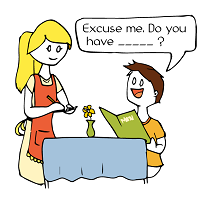
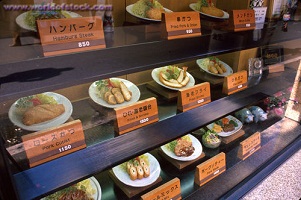 |
|
You want to try おやこどん but you
cannot read menu. If you are not sure they have it, you can ask
them saying:
You: すみません。
おやこどんは ありますか。(If
you have to have it, you many want to ask this before you sit at a
table.
|
Excuse me. Do you have Oyakodon? |
|
Sitting at
a table, if you know they have it. :
You: すみません。 おやこどん(を) おねがい します。
|
I would like to have Oyakodon. |
|
If you want to try a
food that a
waiter is carrying to other table,
(ppointing the food)
and say:
それ(item near you) は 何ですか。
|
What is
that (near
you)? |
Pointing the food that people
over there
are eating.
あれ(item away from both of us) は 何ですか。
|
What is
that (over
there)? |
Japanese menu contains photos of the
food (see the video links in the
Break Time ひとやすみ ) .
Also sample plastic food are usually displayed right outside of the
restaurants. (Do an image search with "Japanese restaurant
display" on line to see various displays right outside the restaurants)
If you can bring a waiter outside, point the plastic display food,
say... これ(item near me)
は 何ですか。
|
What is this? |
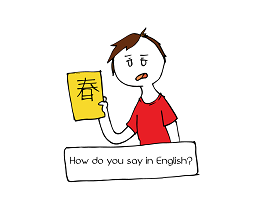 |
If you just want to find out how the food is called (name of the meal),
say これ(or それ or あれ) は にほんごで 何と いいますか.
|
What do you say this (How do say) in Japanese? |
Once you have a waiter understand what you want to have, order it with
the phrase
じゃ、これ(それ/あれ) (を) おねがい します。or
じゃ、これ(それ/あれ)(を) ください。
|
Well then, I would like this. |
|
“ください” can be also used instead of
“おねがいします” if you are requesting an tangible object.
If you are asking for service, use “おねがいします.”
For example, if you are requesting a cab driver to go to
Tokyo
station, say “東京えき, おねがいします.” If you
say "東京えき ください” you
are asking to acquire the station building.
|
Keigo: Respective (Super Polite)
(sometimes grammatically wrong) Expressions you will hear.
Vocabulary Glossary key word
“keigo”
Click here
for Keigo (敬語・けいご).
"Customer is a god" is an expression that
Japanese traditionally use to show to their appreciation to people who are
frequent to their business establishments. Clients and customers and visitors
were paid and treated with extreme care and attention at good establishments. The workers
there sometimes try to be so polite, they end up making up some phrases that are
grammatically wrong and sometimes does not make sense. However these wrong
phrases are so frequently
used among Japanese waiters and waitresses who are just following a restaurant
manual, the over-polite wrong phrases have become natural at some establishments.
In the above fast food conversation the usage of なりますis wrong in
「ラージは420えんに なります」
and 「1300えんに なります。」 なりますmeans "to become (change of a state,
situation, etc.)." The price is set at a certain amount so saying "it
becomes 420 yen" or "It has changed to 1300 yen" is strange but this is a common
expression you hear at a shop. If you hear it used so many times by so
many people, you think that it is a OK phrase.
Here some common polite phrases that are grammatically correct.
|
In ordering as a customer, you will hear very
polite replies from waiters and store clerks.
The following expressions are common phrases.
|
|
Waiter:
お飲みもの は (いかがですか)
|
Would you like a drink?
|
Customer:
いいえ、けっこうです。
|
No, thank you.
|
|
Waiter:
ミックスサンド と ホットコーヒー でございますね?
はい、かしこまりました。
しょう しょう おまちください。
|
(The orders are) Mixed sandwich and hot coffee,
right?
Certainly (I got your order).
Just a moment, please.
"でございます"
is a respective form of です.
|
でございます is a
keiko (respective)
form of です.
かしこまりました is a
keiko (respective) form of わかりました I got it. I
understood.
しょう しょう is a
keiko (respective) form of ちょっと、すこし a bit, a little
Other phrases you will hear at a restaurant:
ごようをうかがっていますか。 Are you being taken care of?
ごちゅうもんをどうぞ or ごちゅうもんはおきまりでしょうか。 Can
I take your order?
(たいへん)おまたせしました。Thank you for waiting.
Numerals and
Numbers
Click
here to learn more about
them.
When you want to order multiple items, here is how to say numbers in
Japanese. The number always come after "noun + particle" phrase, which is
opposite order of English (two sandwich = サンドイッチを ふたつ...、or
サンドイッチは ふたつ... The particle varies depending on the noun
in the sentence (the noun is "the topic" or "a direct object" in the sentence).
サンドイッチを ふたつ ください. Please give me two sandwiches.
ハンバーガーを 3こ と オレンジジュースを みっつ おねがいします。
Sample
Conversation 2: Coffee Shops
Vocabulary Glossary key word
“keigo”
Coffee shops offer variety of dessert, some light snack
type of meals such as sandwiches as well as beverages. You may find some
unique places such as Manga Kissa (Comic book coffee shop). They are
similar to Starbucks (we do have them also in Japan) where you pay for a pretty
good price of a cup of coffee without refills but you can stay there as long as
you want over a cup of tea or coffee with friends if it is not too crowded.
Many places do not separate smoking and non-smoking sections well. I used to
order a desert (any type of パフェ)and did my homework when I was at college.
Some menu items at Coffee Shop (きっさてん):
|
(ホット)コーヒー
|
Coffee
|
|
アイス コーヒー
|
Iced coffee
|
|
レモン ティー
|
Tea with lemon
|
|
ミルク ティー
|
Tea with milk
|
|
モーニングセット/サービス
|
Breakfast combo (toast, coffee or tea, maybe some
salad)
|
|
ランチセット
|
Lunch special
|
|
サンドイッチ
|
Sandwich
|
|
ハムサンド
|
Ham sandwich
|
|
ミックス サンド
|
Mixed Sandwich
(chef’s special)
|
They do not usually lead you to the table at a coffee shop (unless it is a
huge place). Just find a table you want to sit down.

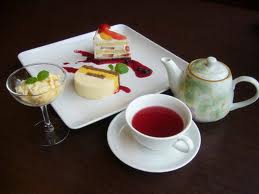
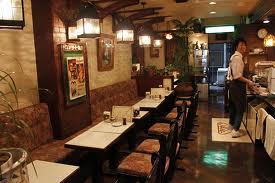 |
Waiter 1: いらっしゃいませ。
|
Welcome.
|
Customer 1: (Sitting at a table) チョコレートパフェを ふたつ ください。
|
Two Chocolate parfait, please. |
Waiter A: チョコレートパフェ を おふたつですね。 かしこまりました。 お飲みものは いかがですか。
|
Two Chocolate parfait, right? Certainly. Would you like a drink? |
Customer 1: わたしは けっこうです。
|
I am fine (no, thank you.) |
Customer 2: わたしは こうちゃを おねがいします。 すみません、わたしは チョコレートパフェはやめて ケーキセットにします。
|
Please (give me) an English tea. I am sorry. I stop (do not
want) Chocolate parfait. I decided on cake combo. |
Waiter A: はい、かしこまりました。 チョコレートパフェを おひとつ、ケーキセットを おひとつで、 おのみものは、こうちゃを おひとつ ですね。 こうちゃは ミルクティーですか。 レモンティーですか。
|
Yes, certainly. One Chocolate parfait and one cake combo.
The drink (of the combo) is an English tea, right? The tea with
milk/cream or tea with lemon? |
Customer 2: えーと、ミルクティーに します。
|
Well... I would like the tea with milk/cream. |
Waiter A: はい、かしこまりました。 しょうしょう おまちください。
|
Yes, certainly. Please wait a moment. |
|
A while later... |
Waiter B: (たいへん)おまたせいたしました。 ケーキセットの おきゃくさまは?
|
Thank you for waiting (quite a while). The customer of cake combo
is...? |
Customer 2: わたしです。(raising a hand)
|
(It is) me.
|
Waiter B: こちら、ミルクティーで ございます。(serving the tea.) You may hear
こちら、ミルクティーに なります。
|
This is a tea with milk. |
Customer 2: どうも。
|
Thanks. |
Waiter B: こちらは チョコレートパフェに なります。
|
This is Chocolate parfait. |
Customer 1: はい、わたしです。 どうも。
|
Yes. it is me.
Thanks. |
Waiter B: いじょうで よろしかったでしょうか。
|
Is that all (your order)? |
Customer 1: はい。どうも。
|
Yes. Thanks. |
Sample Conversation 3: Ordering at a fast food restaurant
Vocabulary Glossary key word
“keigo”

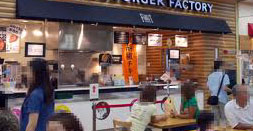
|
お
or ご are honorifics
added to a noun to make the statement polite in talking about
clients/customer as you hear おきゃくさま
a customer/client and
ごちゅうもん an order. You
will be called/addressed as おきゃくさま
or がいこくの おきゃくさま
(customer from foreign country) when they need to call you for an
attention.
|
いらっしゃいませ。 こちらで おめしあがりですか、それとも、おもちかえりですか。
|
May I help you? For here? or to go?
おめしあがりis
the
respective form of 食べます to eat. It is a noun, though.). |
You:
ここで たべます。
(A lot of fast food places are small so they have the second or the
third floors so you may want to add 2かいで たべます to let them know that they
can find you on the second floor if they are bringing food to you later.
The cashier would say おにかいで おめしあがりですね
"You are eating on the 2nd floor"。You even hear the honorific
お added to the word
"にかい 2nd floor ".)
|
I am eating here. |
Cashier:
はい、こちらで おめしあがりですね。 ごちゅうもんを おうかがいいたします。
|
I got it, you are eating here.
I will take your order.
(うかがい is a respective form (a noun) of きく/ ききます "to ask."
The verb form is うかがう) .
いたします is the respective form of する/します. So the direct translation
of おうかがいいたします is "(I) do the asking"
|
You:
チーズバーガー2つと...
飲みものは 何が ありますか。
|
Two cheese burger and...
As
for drinks, what do you have?
|
Cashier: お飲みものは、こちら(pointing
the menu) コーラと スプライトと オレンジジュースが ございます
|
Talking about drinks, this
(pointing the menu) there are (we have)
coke, sprite, and orange juice.ございますis
the
respective form of あります). |
You:
じゃ、スプライトを おねがいします。
|
Well then, I will take sprite. |
Cashier: スモール,ミディアム,ラージが ございますが...。
|
There are (we have) small, medium, and large...
ございます
is the respective form of
あります. |
You:
ミディアムを ください。デザートは なにが ありますか。
|
Medium, please. As
for desert, what do you have? |
Cashier: こちら(pointing
the menu)プリンと コーヒーゼリーと アップルパイが ございます。
|
This
(pointing the menu)
flan, coffee Jell-O, and apple pie. |
You:
ええと、いや、デザートは けっこうです. チーズバーガー 2つと スプライトのミディアムを ください。
|
Well... No, thank you. Two cheeseburger and medium sprint,
please. |
Cashier: フライドポテトはいかがですか。
|
Would you like french fries?
いかがis
a respective form of どう"how."
|
You:
いくらですか。
|
How much (Is it)? |
Cashier: スモールサイズは 280円(えん)、ミディアムは 340円、ラージは420円に なります。
|
The small size is 280yen. The medium is 340 yen. The large us 420
yen. |
You:
じゃ、ラージをください。 ぜんぶ
で(total) いくら ですか。
|
Well then, I will take the large. How much in total? |
Cashier: はい、ありがとうございます。 おかいけい、ぜんぶで 1300円に なります。
|
Thank you very much. The bill is 1300 yen in total. |
You: はい、じゃ、これ。
(Handing over the cash 2000yen)
|
Here with this. |
Cashier: はい、ありがとうございます。 おつり、700円の おかえしに なります。
|
Thank you very much, The change is 700 yen to return. |
Break Time ひとやすみ
Take a break and watch some videos on
Japanese food and restaurants.
Can you work like them at a MacDonald Japan?
http://www.youtube.com/watch?feature=fvwp&v=lVihY7hrZCQ&NR=1
DinerTicket Machine:
https://www.youtube.com/watch?v=KB2aPjwW4PY
Gasuto (a Japanese style family restaurant):
http://www.youtube.com/watch?v=EeUsJy7X3Xg
Denny's in Japan:
http://www.youtube.com/watch?v=bKOAR5aiF90
Okonomiyaki:
http://www.youtube.com/watch?v=lhFnrXnPJ7c
Okonomiyaki (Hiroshima style):
https://www.youtube.com/watch?v=owobcvMlqWQ (fast forward to see what it is
like.)
Takoyaki (egg ball with octopus inside):
http://www.youtube.com/watch?v=fRiHfS8Z65Y
Akashiyaki (egg ball with octopus inside. This is the style that my hometown
is famous for. My mother makes one of the best Kakoyaki! I cannot make it well...
This one shows how to make it but I do not eat it with beer.):
http://www.youtube.com/watch?v=V1VmBWwKJxE
Video on Kushi Katsu,
Okonomiyaki, and Takoyaki made by UNCW students, Nicole Corso and Chang Liu at
https://www.youtube.com/watch?feature=youtu.be&v=ttkizAg7UL8&app=desktop
Daily Activities
(past)
Verbs (past, positive and
negative)
Vocabulary Glossary key word
“daily activities”
Grammar Glossary Key Word “Masu Verb
Conjugations”
Click here for past tense of verbs.
Use
a calendar to practice the following vocabulary. Look at the
date and say the words below.
Words indicating
past:
きょう
today, きのう
yesterday, おととい
the day before yesterday/two days ago, せんしゅう
last week, せんせんしゅう
the week before last week/two weeks ago, きょねん
last year,
さくねん
last year (formal)
Conjunctions:
が but, however (at the end of a sentence
followed by comma instead of period)、そして and
、しかしbut (at the beginning of a sentence. formal)
、だから therefore
Assignment 1:Reading
menus on-line
シカゴ ピザ http://www.chicago-pizza.com/menu/index.html
Go to this pizza web site in Japan. Read menu and write some
ingredients in Japanese that you do not commonly seen in the US. Then
write your observation (look at the sides and drink choices as well) of the
differences and similarities of food culture between Japan and the US.
Beginner write the observation mostly in English while the intermediate write
your observation in
Japanese.
Assignment 2:
Writing a fax order
You are holding a party and invited several Japanese friends who have been
so helpful and to whom you want to repay for their kindness with good hot pizza!
You know that Japanese people eat A LOT. You just received a check
from your work so your budget is 10,000 yen to feed them. Using the pizza shop above
(シカゴ ピザ, write a fax order of three different kinds of pizza (from each
series/category) for the entire party. You know
that one of the Japanese friends like seafood, others like meat and vegetables.
Please include side dishes and drinks as well. If required, remember to
specify the types of crust. Make the total price as close as 10, 000 yen.
Enjoy the pizza shopping!
Note:
Fax machine is commonly used in Japan.
Especially older generations prefer faxing a letter or a note instead of using
e-mail as we often does in the US. A lot of TV programs
use either fax or Keitai (cellphone) for audience to participate in a TV program
or submit feedback and comments about the program. Japanese
emphasize hand-writing practices such as calligraphy. Many Japanese believe
that a
person's hand writing shows the person's intellectual ability or
characters and how much they care about the other since it requires a neat
hand-writing for others to read easily. So write as neat as possible with
phrases to order (not just noun words).
Assignment 3:
Writing Conversations at various restaurants
You are hungry enough to eat a horse
(we actually do have it in a menu at some Japanese restaurants). Pick a place (you
can pick from the list below) to read the menu and order your meals.
Suppose, you have received a meal Boucher (money) from the study abroad program
as follows, 1000 yen for a breakfast, 2000 yen for lunch,
and 3000 yen for dinner. Even if you spend
less, you do not get any cash back or credit so order as much as you can afford
within the budget. Write a name of a restaurant (or the
place you are placing an order) and write out a possible conversation that you
might be having at the place, using as many phrases as you have learned in the
Sample Conversations above as well as a number of menu items at the place you are placing
your orders.
Please include a set menu, drinks, and some deserts. You need to
eat variety of food to keep you healthy.
You have to create conversations at three different restaurants, which can
be a coffee shop, Japanese diner, a Japanese version of American-style
restaurant, and/or a fast food place. Each
situation
has to have a different type of food and a restaurant.
You are most likely
eating breakfast at a fast food restaurant, a coffee shop, bakery shop with
tables or a counter. It is not a common practice for the Japanese to eat
out for breakfast so other types of restaurants are usually open around 11 a.m. for lunch.
If you get a chance, please ask your Japanese partners about the polite phrases
that they hear at a fast food or family restaurant to get some super polite
Keigo Japanese phrases. Some Japanese students may actually work there and have studied a
restaurant manual.
Below is some choices I picked up but you can search and
find others on your own.
モスバーガー http://www.mos.co.jp/menu/
(printable menu)
http://mos.jp/menu/pdf/mos_menu.pdf (this menu will be used for the test.
If the location of the pdf is changed, click here. )
Youtube about Moss Burger:
http://www.youtube.com/watch?v=EeUsJy7X3Xg
http://www.youtube.com/watch?v=bKOAR5aiF90
マクドナルド http://www.mcdonalds.co.jp/menu/burger/index.html
ケンタッキー フライド チキン http://www.kfc.co.jp/menu/set_smile.html
ピザハット http://www.pizzahut.jp/menu/
ミスター ドーナッツ http://www.misterdonut.jp/m_menu/index.html
Youtube about Mr. Donuts:
http://www.youtube.com/watch?v=0F7EgD4JVxw
Western Style Family restaurants:
デニーズ http://www.dennys.jp/
レッドロブスター http://www.redlobster.jp/
ジョイフル
http://www.joyfull.co.jp/
(Look around and find your favorite.
This menu will be used for the test)
ハンバーグ(hamburger-like
streak) http://www.joyfull.co.jp/menu/grand/hamburg_combo/
サラダ http://www.joyfull.co.jp/menu/grand/side/
デザート http://www.joyfull.co.jp/menu/grand/dessert/
Note: You may see a word "バー " such as " スープバー " and "
ドリンクバー , " which means "soup buffet" or "drink buffet." You
can eat or drink as much as you like in the category with an extra payment for
the deal.
Assignment 4:
Recording "What
you did during a summer break."
Vocabulary Glossary key word
“daily activities-writingLetter”
Vocabulary
Glossary key word “holidays-vacations"
Summer is almost over. You have realized that you
have not written to a Japanese friend for a while. Practice reading the following
passage aloud, record (your recording should be less than 90 seconds) stop
watch here at
http://www.online-stopwatch.com/full-screen-stopwatch/ and submit it
to my e-mail or Voice Mail in the Blackboard. Also submit the translation typed in a document file such as Microsoft Word or
equivalent. Your reading shows how much you understand the passage.
Please translate it first.
|
Beginner:
おひさしぶりです。 おげんきですか。 なつ休みは もう あしたで おわりです。 ことしは いろんなことを しました。 まずは、6月に 日本に 行きました。 日本で 京都のホテルに 7はく とまりました。 京都で 金閣寺や 清水寺を かんこうしました。日本りょうりも たくさん 食べました。日本の おすしは ほんとうに おいしいです。 こんかいは 東京へは 行きませんでしたが、しょうらい、また、行きます。 そのあと、アメリカに かえりました。 アメリカでは まいにち しょくりょうひんてんで あさの 10じから ゆうがたの 5じまで アルバイトを しました。 日本で おみやげを たくさん 買いました。 いま、クレジットカードの しはらいが たいへんです。 あしたから がっこうが はじまります。 ひろこさんの なつ休みは どうでしたか。 じゃ、また、おたよりします。おげんきで。
|
Assignment 5 :
Writing about what you did in Kyoto
Look at our itinerary in Japan (Click
here) and write what you will do in Kyoto before you meet your homestay
family, Japanese friends, or Japanese people whom you will meet (we usually find
some women talk to us on buses). This will help you to practice some
conversation with them. They will be curious to know what you have done or
will do in Japan. Take lots of photos for show-and-tell!.
Assignment 6:
Writing your past activities
Write about your past activities (think about some big events such as
Christmas, Birthday, summer break, etc.), using various verbs in the past. You can make up a
story if you do not remember what you did. The point is to practice "past
tense of verbs"
and "words indicating past." Remember to include negative forms as well.
You can write about what you did during winter break,
Christmas(クリスマス), Thanksgiving(感謝祭 かんしゃさい), etc. Pick some highlighted events. Make sure
you will use "non-past" forms of verbs if you are taking about habitual actions
such as "you eat (habitual action) turkey every year during Thanksgiving but this year
you did not eat it but instead you ate a big tray of sushi! Beginners should
write at least 200 characters (no space). "At least" means "passing D grade"
Write as much as you can (refer to the grading criteria for writing). Intermediate students should
write at least 300 characters (no space). All the writing assignment
should be hand-written and submit via e-mail.
Assignment 7:
Recording about what your Japanese partner did...
Ask your partner in Japanese (beginners: talk in
Japanese as much as you can. Intermediate: try to conduct this
conversation entirely in Japanese. The classroom instructions that you
learned in the Chapter 0 will be helpful to ask them "how do you say ... in
English or "Please repeat it", etc.) what they did in the past (last week, last
month, last summer vacation なつ休み, winter break ふゆ休み, spring break はる休み, etc.)
summarize your interview in one paragraph and turn it in. Click
here for the note to request "Japanese only"







